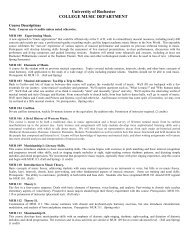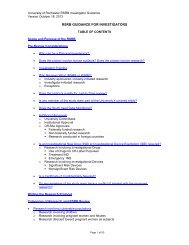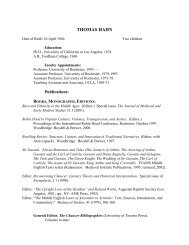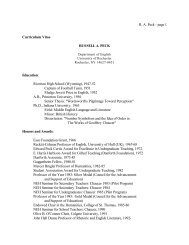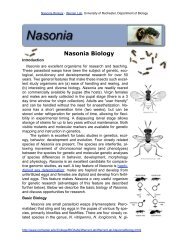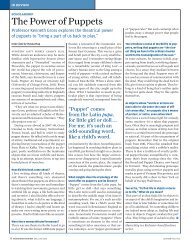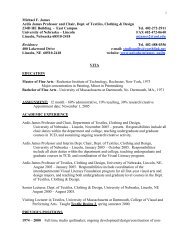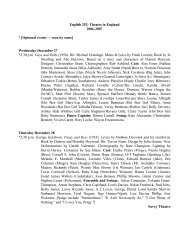JAGS Tutorial
JAGS Tutorial
JAGS Tutorial
You also want an ePaper? Increase the reach of your titles
YUMPU automatically turns print PDFs into web optimized ePapers that Google loves.
1. What is <strong>JAGS</strong>?<br />
<strong>JAGS</strong> <strong>Tutorial</strong><br />
<strong>JAGS</strong> stands for “Just Another Gibbs Sampler” and is a tool for analysis of Bayesian<br />
hierarchical models using Markov Chain Monte Carlo (MCMC) simulation. <strong>JAGS</strong> is an engine<br />
for running BUGS in Unix-based environments and allows users to write their own functions,<br />
distributions and samplers.<br />
[Source: http://www-ice.iarc.fr/~martyn/software/jags/]<br />
2. What is R2jags?<br />
R2jags is an R package used to call <strong>JAGS</strong> from R.<br />
3. Function Usage for R2jags Package<br />
[Original full documentation at http://cran.r-project.org/web/packages/R2jags/R2jags.pdf]<br />
autojags: Function for auto-updating jags until the model converges<br />
Usage<br />
update(object, n.iter=1000, n.thin=1, refresh=n.iter/50, progress.bar = "text", ...)<br />
autojags(object, n.iter=1000, n.thin=1, Rhat=1.1, n.update=2, refresh=n.iter/50,<br />
progress.bar = "text", ...)<br />
Arguments<br />
object an object of rjags class<br />
n.iter number of total iterations per chain (default=1000)<br />
n.thin thinning rate, must be a positive integer (default=1)<br />
... further arguments pass to or from other methods<br />
Rhat convergence criterion (default=1.1)<br />
n.update the max number of updates (default=2)<br />
refresh refresh frequency for progress bar (default=n.iter/50)<br />
progress.bar type of progress bar (“text” -- displayed on the R console; “gui” -- graphical progress<br />
bar in a new window; "none" -- progress bar is suppressed)<br />
jags: Automatically writes a jags script, calls the model, and saves the simulations for easy access in R.<br />
Usage<br />
jags(data, inits, parameters.to.save, model.file="model.bug", n.chains=3, n.iter=2000,<br />
n.burnin=floor(n.iter/2), n.thin=max(1, floor((n.iter - n.burnin) / n.sims)),<br />
n.sims = 1000, DIC=TRUE, working.directory=NULL, refresh = n.iter/50,<br />
progress.bar = "text")<br />
jags2(data, inits, parameters.to.save, model.file="model.bug", n.chains=3,<br />
n.iter=2000, n.burnin=floor(n.iter/2), n.thin=max(1, floor((n.iter - n.burnin)<br />
/ n.sims)), n.sims = 1000, DIC=TRUE, jags.path="", working.directory=NULL,<br />
clearWD=TRUE, refresh = n.iter/50)
Arguments<br />
data a vector or list of the names of the data objects used by the model<br />
inits a list with n.chains elements; each element of the list is itself a list of starting values<br />
for the BUGS model, or a function creating (possibly random) initial values; if inits is<br />
NULL, <strong>JAGS</strong> will generate initial values for parameters<br />
parameters.to.save character vector of the names of the parameters to save<br />
model.file file containing the model written in BUGS code<br />
n.chains number of Markov chains (default=3)<br />
n.iter number of total iterations per chain (including burn in; default=2000)<br />
n.burnin length of burn in, i.e. number of iterations to discard at beginning (default=n.iter/2;<br />
if n.burnin=0, jags() will run 100 iterations for adaption)<br />
n.thin thinning rate, must be a positive integer (default is max(1, floor(n.chains * (n.itern.burnin)<br />
/ 1000)) which will only thin if there are at least 2000 simulations)<br />
n.sims approximate number of simulations to keep after thinning<br />
DIC logical; if TRUE (default), compute deviance, pD, and DIC; pD=var(deviance) / 2<br />
working.directory sets working directory (should be where model file is)<br />
jags.path directory that contains the jags executable (default=“”)<br />
clearWD indicates whether ‘data.txt’, ‘inits[1:n.chains].txt’, ‘codaIndex.txt’, ‘jagsscript.txt’, and<br />
‘CODAchain[1:nchains].txt’ should be removed after jags finishes (default=TRUE)<br />
refresh refresh frequency for progress bar, default is n.iter/50<br />
progress.bar type of progress bar (“text” -- displayed on the R console; “gui” -- graphical progress<br />
bar in a new window; "none" -- progress bar is suppressed)<br />
jags2bugs: Reads jags output files in CODA format and returns an object of class mcmc.list for further output<br />
analysis using the coda package.<br />
Usage<br />
jags2bugs(path=getwd(), parameters.to.save, n.chains=3, n.iter=2000, n.burnin=1000,<br />
n.thin=2, DIC=TRUE)<br />
Arguments<br />
path sets working directory (should be where CODA files are)<br />
parameters.to.save character vector of the names of the parameters to save<br />
n.chains number of Markov chains (default=3)<br />
n.iter number of total iterations per chain (including burn in; default=2000)<br />
n.burnin length of burn in, i.e. number of iterations to discard at beginning (default=n.iter/2)<br />
n.thin thinning rate (default=2)<br />
DIC logical; if TRUE (default), compute deviance, pD, and DIC; pD=var(deviance) / 2<br />
recompile: Function for recompiling previously saved rjags object<br />
Usage<br />
recompile(object, n.iter=100, refresh=n.iter/50, progress.bar = "text")<br />
Arguments<br />
object an object of rjags class.<br />
n.iter number of iteration for adapting (default=100)<br />
refresh refresh frequency for progress bar (default= n.iter/50)<br />
progress.bar type of progress bar (“text” -- displayed on the R console; “gui” -- graphical progress<br />
bar in a new window; "none" -- progress bar is suppressed)
traceplot: Displays a plot of iterations vs. sampled values for each variable in the chain.<br />
Usage<br />
traceplot(x, ...)<br />
traceplot(x, mfrow = c(1, 1), varname = NULL, match.head = TRUE, ask = TRUE,<br />
col = rainbow( x$n.chains ), lty = 1, lwd = 1, ...)<br />
Arguments<br />
x A bugs object<br />
mfrow graphical parameter (see par)<br />
varname vector of variable names to plot<br />
match.head matches the variable names by the beginning of the variable names in bugs object<br />
ask logical; if TRUE, the user is asked before each plot, see par(ask=.).<br />
col graphical parameter (see par)<br />
lty graphical parameter (see par)<br />
lwd graphical parameter (see par)<br />
... further graphical parameters<br />
4. Example: week2.R<br />
[Example source: http://cran.r-project.org/web/packages/R2jags/R2jags.pdf]<br />
Programming steps:<br />
1. Write a BUGS model in an ASCII file.<br />
2. Open R.<br />
3. Prepare the inputs for the jags function and run it.<br />
4. The model will now run in <strong>JAGS</strong>. You will see progress in the R console.<br />
Example code:<br />
# R code: rjags test<br />
# Bayesian Data Analysis<br />
library(rjags)<br />
library(R2jags)<br />
# An example model file is given in: /usr/local/lib/R/library/R2jags/model<br />
# the plotted graphic is shown in your current directory by default, named Rplots.pdf<br />
# load the file (Copy it to your R working directory if necessary)<br />
model.file
#=============#<br />
# using jags #<br />
#=============#<br />
jagsfit




